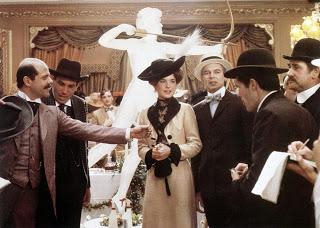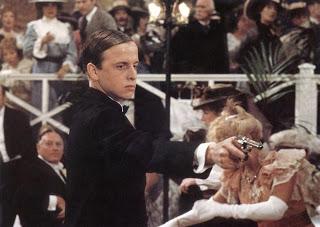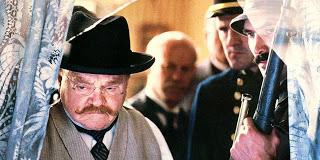
"I've spent my whole life forgetting. You're a young man. You better start learning now."
Milos Forman's Ragtime (1981) commits to an insurmountable task: turning E.L. Doctorow's kaleidoscopic novel of early 1900's America into a 155 minute movie. The result's a frustrating half-masterpiece, a wildly ambitious, occasionally fascinating film that bites off more than it can chew.New York, 1906: socialite Evelyn Nesbit (Elizabeth McGovern) watches husband Harry Thaw (Robert Joy) publicly murder her ex-lover, architect Stanford White (Norman Mailer) in Madison Square Garden. Thaw's trial becomes a society scandal; Evelyn begins an affair with Younger Brother (Brad Dourif), son of a fireworks tycoon (James Olson), while working to capitalize off her notoriety. A parallel story involves Coalhouse Walker, Jr. (Howard E. Rollins, Jr.), a black musician whose girlfriend Sarah (Debbie Allen) works for Brother's family. Radicalized by racist humiliations, Walker forms a gang that terrorizes New York until he's cornered by police into a violent last stand.
Doctorow's novel, a patchwork of interlocking vignettes, subplots and historical cameos, defies easy adaptation; even a miniseries would struggle to capture everything. Forman and writer Michael Weller streamline the material by amputating key scenes, which perversely compounds the scattershot feel. For instance, Evelyn and Younger Brother's first meeting, a sexually explosive confrontation involving Emma Goldman (!!!), was filmed but cut; Evelyn's later, violent reaction to his overtures thus lacks discernible motivation. Subplots featuring real-life personages are either excised entirely (Harry Houdini) or shrunk to thumbnail sketches (Sarah's encounter with Teddy Roosevelt). Individually, these cuts are minor slights; collectively, they erode the story's texture.

Ragtime is certainly beautiful, with Forman beautifully recreating 1900s New York (sometimes on location, sometimes at London's Shepperton Studios) through lavish set pieces alternating between WASP estates and beach resorts, Irish firehouses, Jewish ghettos and black slums. The ironies Forman presents are obvious but effective: murders and assaults carried out in high society, the orphaned child left at New Rochelle, legal contracts negotiated while Evelyn's in flagrante with Brother. Miroslav Ondříček provides gorgeous photography that's beautiful without seeming unduly nostalgic, complemented by Randy Newman's lively score. It's all very evocative, even when it feels empty.

Ultimately, Ragtime turns into a treatise on class warfare. Wealthy Americans not only get away with crimes but achieve celebrity through their misdeeds; working class criminals, especially blacks, become monsters worthy of extermination. City officials fret more over the J.P. Morgan property invested by Coalhouse's gang than their threat to human lives; supposedly enlightened leaders like Washington merely put a progressive gloss on protecting the system. Near the end, Coalhouse echoes dialog from Harry Thaw in justifying his crimes: entitled white men cast their petty grievances as equal to the underclass's existential crises. Sadly, today Thaw's entitled whining seems less psychotic than commonplace white privilege.
Ragtime features a robustly eclectic cast: Hollywood legends James Cagney, Pat O'Brien and Donald O'Connor rub shoulders with future stars Jeff Daniels, Fran Drescher and Samuel L. Jackson. Bigger roles are a mixed bag: James Olson's upright grouchiness clashes well with Mary Steenburgen's brittle generosity, but Nancy Allen is too much of a quivering cipher to make an impression. Mandy Patinkin has a curious bit as a street artist who fascinates Evelyn, then resurfaces later as a film director. Cagney's police commissioner isn't much more developed, but his grizzled gravitas makes his scenes count.

Ragtime later inspired an acclaimed stage musical that much better captures the novel's riotous, disjointed energy. Forman's film is a good try, an interesting, lavish but overachieving misfire. Then again, considering the source book, how could it be anything else?

